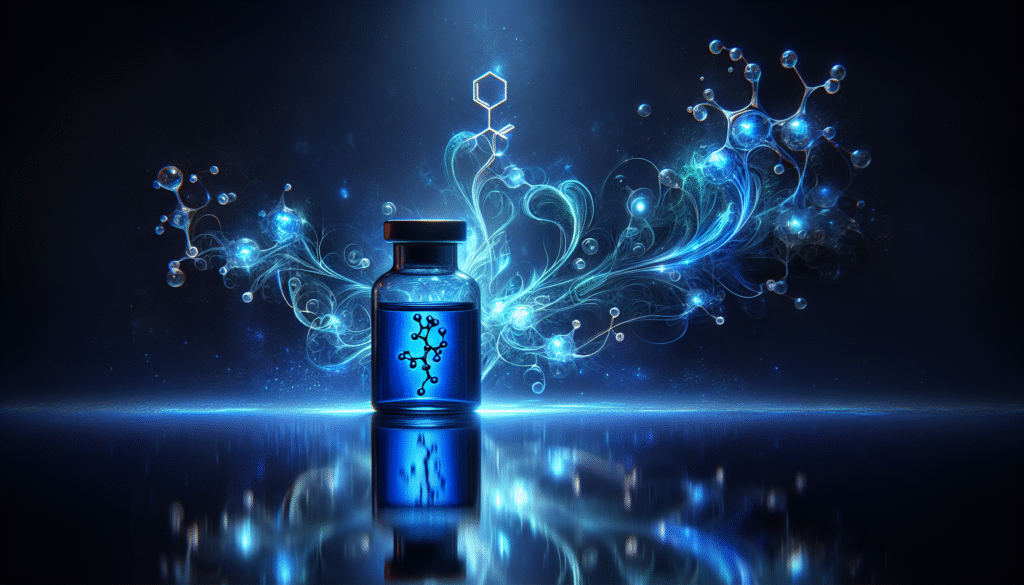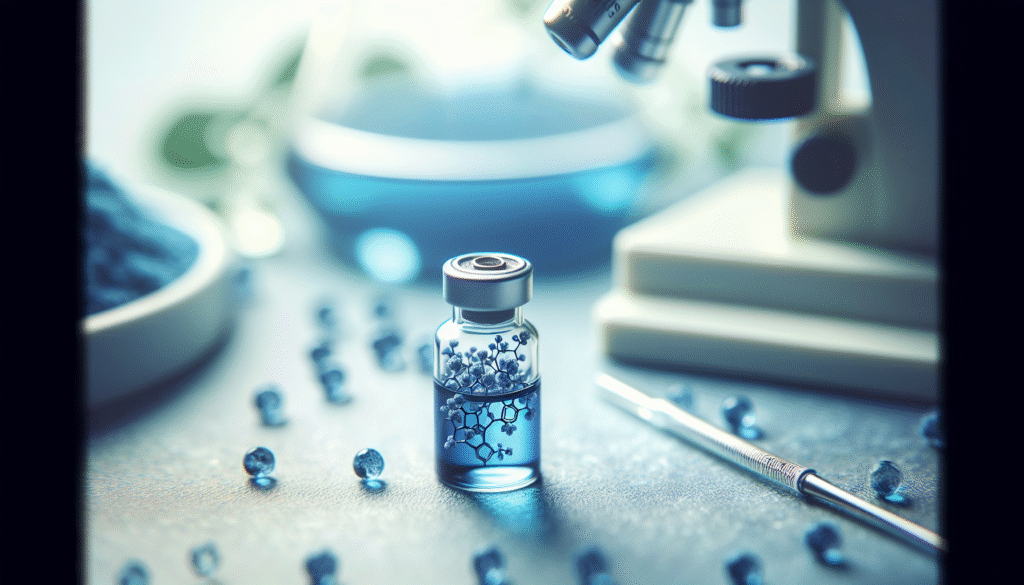
What if there was a compound capable of not only coloring solutions but also potentially offering significant health benefits? Methylene blue, a synthetic dye with a long history in the medical field, has garnered attention for its possible antioxidant properties. This article aims to elucidate the role of methylene blue as an antioxidant, its mechanisms of action, and its implications for health.

What is Methylene Blue?
Methylene blue is a chemical compound that was first synthesized in the 19th century and is used in various applications, from biology to medicine. Initially employed as a textile dye, it quickly found its way into microbiology as a stain for biological samples. However, its role in medicine, especially in the treatment of methemoglobinemia—a condition where hemoglobin is unable to effectively release oxygen to body tissues—has highlighted its therapeutic potential.
Historical Context
The historical significance of methylene blue cannot be understated. Its introduction into medicine occurred in the 1890s, marking it as one of the first synthetic dyes used as a drug. Beyond its role in treating blood-related conditions, research into methylene blue expanded over the years, revealing its potential in treating neurodegenerative diseases, infections, and even as an adjunct in cancer therapy.
Nevertheless, the exploration of methylene blue’s antioxidant properties provides a newer avenue of investigation into its therapeutic capabilities. Understanding how it acts as an antioxidant requires a basic grasp of oxidative stress and its impact on cellular health.
The Science Behind Oxidative Stress
Oxidative stress arises when there is an imbalance between free radicals and antioxidants in the body. Free radicals are unstable molecules that can damage cells, proteins, and DNA. The body naturally produces free radicals during metabolism, but external factors like pollution, radiation, and smoking can exacerbate their levels.
Free Radicals Explained
Free radicals are atoms or molecules that have unpaired electrons, making them highly reactive. They seek stability by interacting with other molecules, leading to a chain reaction of damage in biological systems. If not adequately neutralized by antioxidants, this process can result in cellular dysfunction, contributing to aging and various health conditions.
Antioxidants Defined
Antioxidants are substances that counteract oxidative stress by neutralizing free radicals. They donate electrons to these unstable molecules, stabilizing them and preventing cellular damage. The body produces some antioxidants endogenously, but dietary sources and supplements significantly contribute to overall antioxidant capacity.
Methylene Blue as an Antioxidant
Emerging research has positioned methylene blue as a potential player in the antioxidant arena. Its unique chemical structure enables it to interact with free radicals effectively, providing a protective effect on cells.
Mechanisms of Action
Methylene blue’s antioxidant properties can be attributed to several mechanisms:
-
Electron Donation: Methylene blue can act as a reducing agent, donating electrons to free radicals and thus neutralizing them. This basic chemical property underpins its ability to mitigate oxidative stress.
-
Interaction with Mitochondria: There is growing evidence that methylene blue influences mitochondrial function. By enhancing mitochondrial respiration, it may improve energy production and reduce the generation of harmful reactive oxygen species (ROS).
-
Regeneration of Antioxidants: Methylene blue has been shown to regenerate other antioxidants, such as glutathione, which plays a critical role in neutralizing free radicals.
Research Findings
Various studies have indicated the potential of methylene blue as an effective antioxidant. A notable study published in the journal “Free Radical Biology and Medicine” detailed methylene blue’s ability to reduce oxidative stress in cellular models, demonstrating its protective effects against cellular damage.
Moreover, in preclinical studies involving animal models, methylene blue appeared to enhance neuroprotective effects by lowering oxidative stress markers in brains subjected to oxidative damage.
Health Implications of Methylene Blue’s Antioxidant Properties
The health implications resulting from the antioxidant properties of methylene blue are vast. Potential applications range from neuroprotection to anti-aging effects, warranting a closer examination of its therapeutic benefits.
Neuroprotection
One of the most promising applications of methylene blue is its use in neurodegenerative diseases. Conditions such as Alzheimer’s and Parkinson’s disease are characterized by increased oxidative stress and neuronal degeneration. By acting as an antioxidant, methylene blue may aid in protecting neurons and maintaining cognitive function.
Alzheimer’s Disease and Methylene Blue
Research has pointed to methylene blue’s potential in reducing the formation of tau protein tangles, a hallmark of Alzheimer’s disease. Its ability to enhance mitochondrial function further supports its neuroprotective attributes.
Anti-Aging Effects
Although aging is a natural process, the accompanying oxidative stress can accelerate cellular degeneration. As a potent antioxidant, methylene blue may contribute to extending lifespan and enhancing the quality of life by reducing oxidative damage to cells.
Cancer Therapy
Preclinical studies have shown that methylene blue can induce apoptosis (programmed cell death) in certain cancer cell lines while protecting healthy cells from oxidative damage. This duality presents a compelling case for its incorporation into cancer treatment paradigms, potentially as an adjunct therapy.

Practical Applications
Understanding the antioxidant properties of methylene blue could lead to practical applications across various domains. Its versatility as a compound is a notable advantage.
Medical Applications
-
Administration in Clinical Settings: In hospitals, methylene blue is well-established for treating methemoglobinemia and managing certain urinary tract infections. Ongoing research into its antioxidant capabilities may expand its clinical applications further.
-
Potential Neuroprotective Supplement: While research is still in its early stages, methylene blue could eventually be developed into a dietary supplement aimed at cognitive health.
Research Exploration
Ongoing and future research will further elucidate not only the mechanisms through which methylene blue acts as an antioxidant but also the parameters for safe and effective usage in clinical practice.
Researchers are focusing on:
-
Optimal Dosages: Determining the most effective dosages and delivery methods for therapeutic applications.
-
Targeted Therapeutic Use: Establishing guidelines for utilizing methylene blue in specific conditions characterized by oxidative stress.
Safety and Side Effects
While methylene blue presents itself as a promising antioxidant agent, discussions of its benefits must also encompass considerations regarding safety and potential side effects.
Common Side Effects
Methylene blue is generally well-tolerated in clinical settings; however, patients may experience adverse effects, including:
-
Skin Discoloration: Since methylene blue is a dye, its use can lead to temporary discoloration of the skin and urine.
-
Serotonin Syndrome: When used concurrently with certain medications, such as antidepressants, methylene blue may precipitate serotonin syndrome, a serious condition that can arise from excessive serotonin levels.
Contraindications
Individuals with specific health conditions should consult a healthcare provider prior to using methylene blue. Pregnant or breastfeeding individuals, as well as those with a history of hypersensitivity to the compound, should avoid its usage.

Future Directions in Research
The exploration of methylene blue’s antioxidant properties is a burgeoning field of inquiry. Moving forward, understanding its comprehensive effects will hinge on rigorous, multidisciplinary research.
Clinical Trials
Ongoing clinical trials are essential for verifying the effectiveness of methylene blue as an antioxidant treatment. These studies will provide a deeper understanding of its mechanisms, optimal dosages, and safety profiles.
Innovations in Formulations
Future formulations may include the development of methylene blue in combination with other agents to enhance its therapeutic efficacy. Conjugated compounds or nanoparticles might optimize the delivery and effectiveness of methylene blue as an antioxidant.
Broader Implications
In addition to its role in neuroprotection, methylene blue’s applications could extend to other conditions exacerbated by oxidative stress, including cardiovascular diseases, diabetes, and inflammatory disorders.
Conclusion
In the realm of antioxidants, methylene blue stands out as a compound with significant clinical potential. Its unique properties offer a glimpse into a multifunctional agent capable of addressing oxidative stress, protecting cellular health, and promoting various therapeutic applications.
As research continues to unfold, methylene blue’s status may evolve from a historical dye to a frontline agent in the fight against oxidative stress-related conditions. Your engagement with this topic positions you at the forefront of an exciting scientific frontier where a compound initially known for its color could illuminate pathways to better health and longevity. The implications of its antioxidant properties are far-reaching, and understanding them can empower you with insights into managing well-being in an increasingly stressful world.
